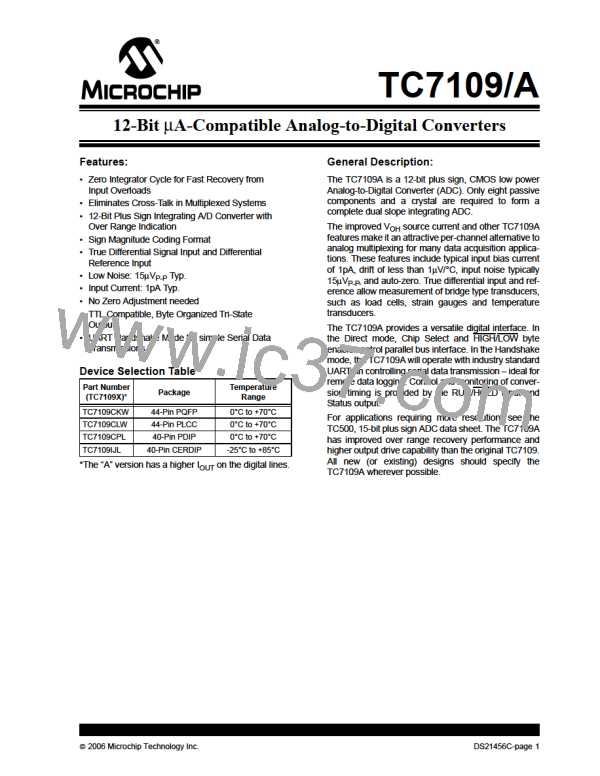TC7109/A
this very linear region over the input voltage range, but
small enough that undue leakage requirements are not
placed on the PC board. For 2.048V full scale, a 100kΩ
resistor is recommended and for 409.6mV full scale, a
20k resistor is recommended. RINT may be selected for
other values of full scale by:
3.4
Test Input
The counter and its outputs may be tested easily. When
the TEST input is connected to GND, the internal clock
is disabled and the counter outputs are all forced into
the HIGH state. When the input returns to the 1/2
(V+ – GND) voltage or to V+ and one clock is input, the
counter outputs will all be clocked to the LOW state.
EQUATION 3-3:
The counter output latches are enabled when the TEST
input is taken to a level halfway between V+ and GND,
allowing the counter contents to be examined any time.
Full Scale Voltage
RINT
=
20 μA
3.5.3
AUTO-ZERO CAPACITOR
3.5
Component Value Selection
As the auto-zero capacitor is made large, the system
noise is reduced. Since the TC7109A incorporates a
zero integrator cycle, the size of the auto-zero capaci-
tor does not affect overload recovery. The optimal value
of the auto-zero capacitor is between 2 and 4 times
CINT. A typical value for CAZ is 0.33μF.
The integrator output swing for full scale should be as
large as possible. For example, with ±5V supplies and
COMMON connected to GND, the nominal integrator
output swing at full scale is ±4V. Since the integrator
output can go to 0.3V from either supply without signif-
icantly effecting linearity, a 4V integrator output swing
allows 0.7V for variations in output swing, due to com-
ponent value and oscillator tolerances. With ±5V sup-
plies and a Common mode voltage range of ±1V
required, the component values should be selected to
provide ±3V integrator output swing. Noise and roll-
over errors will be slightly worse than in the ±4V case.
For large Common mode voltage ranges, the integrator
output swing must be reduced further. This will
increase both noise and rollover errors. To improve
performance, ±6V supplies may be used.
The inner foil of CAZ should be connected to Pin 31 and
the outer foil to the RC summing junction. The inner foil
of CINT should be connected to the RC summing
junction and the outer foil to Pin 32, for best rejection of
stray pickups.
3.5.4
REFERENCE CAPACITOR
A 1μF capacitor is recommended for most circuits.
However, where a large Common mode voltage exists,
a larger value is required to prevent rollover error (e.g.,
the reference low is not analog common), and a
409.6mV scale is used. The rollover error will be held
to 0.5 count with a 10μF capacitor.
3.5.1
INTEGRATING CAPACITOR
The integrating capacitor, CINT, should be selected to
give the maximum integrator output voltage swing that
will not saturate the integrator to within 0.3V from either
supply. A ±3.5V to ±4V integrator output swing is nom-
inal for the TC7109A, with ±5V supplies and analog
common connected to GND. For 7-1/2 conversions per
second (61.72kHz internal clock frequency), nominal
values CINT and CAZ are 0.15μF and 0.33μF, respec-
tively. These values should be changed if different
clock frequencies are used to maintain the integrator
output voltage swing. The value of CINT is given by:
3.5.5
REFERENCE VOLTAGE
To generate full scale output of 4096 counts, the analog
input required is VIN = 2VREF. For 409.6mV full scale,
use a reference of 204.8mV. In many applications,
where the ADC is connected to a transducer, a scale
factor will exist between the input voltage and the digital
reading. For instance, in a measuring system, the
designer might like to have a full scale reading when
the voltage for the transducer is 700mV. Instead of
dividing the input down to 409.6mV, the designer
should use the input voltage directly and select
VREF = 350mV. Suitable values for integrating resistor
and capacitor would be 34kΩ and 0.15μF. This makes
the system slightly quieter and also avoids a divider
network on the input. Another advantage of this system
occurs when temperature and weight measurements,
with an offset or tare, are desired for non-zero input.
The offset may be introduced by connecting the voltage
output of the transducer between common and analog
high, and the offset voltage between common and ana-
log low, observing polarities carefully. In processor
based systems using the TC7109A, it may be more
desirable to use software and perform this type of
scaling or tare subtraction digitally.
EQUATION 3-2:
(2048 Clock Period) (20 μA)
CINT
=
Integrator Output Voltage Swings
The integrating capacitor must have low dielectric
absorption to prevent rollover errors. Polypropylene
capacitors give undetectable errors, at reasonable
cost, up to +85°C.
3.5.2
INTEGRATING RESISTOR
The integrator and buffer amplifiers have a class A out-
put stage with 100μA of quiescent current. They supply
20μA of drive current with negligible non-linearity. The
integrating resistor should be large enough to remain in
© 2006 Microchip Technology Inc.
DS21456C-page 15

 MICROCHIP [ MICROCHIP ]
MICROCHIP [ MICROCHIP ]